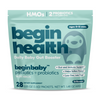Is Your Baby’s Formula Missing This Key Ingredient?
share this article

When choosing the right formula for your baby, you probably compare protein types, iron content, and whether it’s organic or gentle on tiny tummies. But there’s one ingredient many parents don’t realize is missing from most formulas—Human Milk Oligosaccharides (HMOs). These special prebiotics are the third most abundant solid in breast milk, yet they’re often absent or present in only small amounts in infant formula.
So what exactly are HMOs and why should you care if they’re in your baby’s bottle?
What Are HMOs?
Human Milk Oligosaccharides (HMOs) are complex carbohydrates found only in human breast milk. They aren’t digested by babies for nutrition. Instead, they serve as food for the good gut bacteria, especially Bifidobacteria, which play a critical role in immune and digestive development [1].
There are over 200 types of HMOs in breast milk, but 2'-Fucosyllactose (2'-FL) is the most abundant and best-studied.
Research shows that 2'-FL supports immune function, strengthens the gut barrier, and helps protect against harmful bacteria by acting as a decoy, preventing them from attaching to the baby’s intestinal lining [2].
Why Most Formulas Don’t Include HMOs
Until recently, HMOs were nearly impossible to replicate outside of breast milk. But advances in biotechnology now allow specific HMOs like 2’-FL to be produced using lactose fermentation. Some formula brands have started adding them—but not all do, and very few include more than one or two types.
If your formula doesn't contain HMOs, it may not be offering the same gut microbiome support that breastfed babies naturally receive.
Why HMOs Matter for Your Baby
-
Supports a Healthy Gut Microbiome: HMOs selectively feed Bifidobacterium longum subsp. infantis (B. infantis), a key species that dominates the gut of breastfed babies and plays a vital role in immune and metabolic health [5].
-
Protects Against Infection: HMOs may help reduce the risk of gastrointestinal and respiratory infections in infants by preventing pathogen adhesion and modulating immune responses [4].
-
Promotes Softer, More Regular Stools: Because HMOs help establish a beneficial gut microbiome, they may lead to better stooling patterns and reduce fussiness caused by gas or constipation.
How to Tell If Your Baby’s Formula Contains HMOs
Check the ingredient label for 2’-Fucosyllactose (2’-FL) HMOs. Look for formulas that specify “Human Milk Oligosaccharides” or “HMO Prebiotics”, not just “prebiotics,” which often refer to generic fibers like galacto-oligosaccharides (GOS) or fructo-oligosaccharides (FOS), which aren’t unique to human milk.
Summary
HMOs are a critical component of breast milk that help nourish your baby’s gut and immune system but many infant formulas still don’t contain them. If you’re formula-feeding, choosing a formula with 2’-FL or other HMOs can help bridge the nutritional gap between breast milk and formula.
















